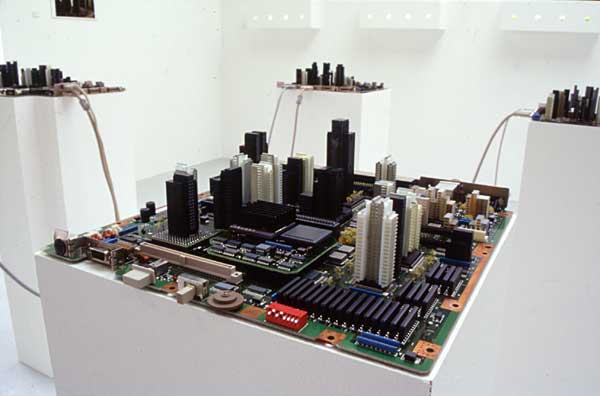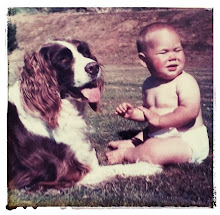Duncan Speakman duncanspeakman.net'Sound artist'. Started off as a sound engineer, went into documentary-making and then sound making (interactive design). Site specific work ('no gallery' policy). Using public/online spaces, MP3 players and locative technology.
A particular influence at an early age was a film called 'Iron Eagle'.
He was inspired by the character's idea to strap a music source to his leg when he was flying, to create a soundtrack to his flight- soundtracking the moment. Speakman took to taping his Dad's Walkman to his leg whilst skateboarding, playing something like Beethoven's 9th Symphony.
"An object cannot compete with an experience" - Hamish FultonEphemerality - temporal moment. Making invisible permanent pieces that require no planning permission.
"Walking in particular drifting, or strolling, is already- with in the speed culture of our time- a kind of resistance" -
Francis AlysAcoustic ecology - movement - not much of an awareness of sound and its influences over us. Schizophrenic sound - removed from original source. Ghosting effect & heightening --> articifical-sounding. Sculpting the world- lazy filmmaker.
"...as a manager of sensorial channels, it questions the relationship between the dweller and his environment and enables new modes of experiencing the city" - Jean Paul ThibaudUltrared - recognise sound as a residue of social space. Nostaligic & melancholia.
Piece- flowerpots containing microphones which fed out the recorded conversations onto printed sheets in the Watershed cafe. People reading the printed out sheets would create a recorded cycle. Another piece where an internet chatroom fed to live performers filmed, shown on the net - 'Live Chat'.
Video of a soundwalk. Memory/sight/place. Site specific.
'Sounds From Above The Ground' - Rucksacks with laptop & headphones- two characters are arguing - records current sounds and adds them later and charges order or direction.
Piece - Speakman would walk ahead recording sounds around him which would be relayed to audience following behind. They would hear a noise of eg a door opening before they got to the door.
'Always Something Somewhere Else' - in conjunction with Hewlett Packard. Generative soundwalk. Had to find a specific item - tree or bench etc - which would trigger a story on a handheld GPS device.
'My World Is Empty Without You' (Wings of Desire) - Sent to walk round a city listening to an MP3 player. A performer approaches and speaks part of what the audience is listening to, triggered by the performer via Wifi. To get people to feel more engaged with and connected to the people around them instead of being a passive observer listening to their own, disconnected soundtrack.
Next project- May 14/15/16 - Mayfest
'My World Is Empty Without You'From
mayfestbristol.co.uk: What happens when everyone in the city is listening to the same song? Wearing headphones, the audience travels across the city, an immersive soundtrack filling their ears, turning the world around into a poignant and personal cinema.
As strangers drift past you and events unfold it becomes harder to separate the staged and the real.
Exploring ideas of social disconnection in the age of the iPod; part love song, part theatre … My World is Empty Without You will leave marks in your heart.
My World is Empty Without You is a development of Duncan Speakman’s piece of the same name shown at Mayfest 2008.Commissioned by Mayfest, supported by Arnolfini and developed at the Pervasive Media Studio.
"If contemporary audiences are only interested in experience, can we disguise content as experience?" - ?
Paul Thirkel
Etching, woodblock, print. Creates narrative by layering, simplifying. Increasing size of small items. Photogravure. Research old printing- collotype --> Darwin's Expressions of Emotion in Man & Animals used this technique.

Photos of fruit making patterns. Printed one image in 22 different mediums for use as reference material. Digital arts portfolio. Digitally generated collotype. Collage, photocollage. Max Ernst. Printing process can abstract an image. Duchamp- The Green Box. Henry Moore & Richard Hamilton also translated notes from La Boite Verte.
CNC Milling: creates a mold using a photo, use the mold to create a positive impression and impress that into a ceramic tile. Then flood the tile with glaze and it creates the photograph on ceramic. Research into 3D colour printing.
Peter WaltersFine Print Research. Originally engineering draftsman for 2 years, then studied Industrial Design BA, MA, PhD in Sheffield. For MA designed a pair of Toucan secateurs for ease of use an to being some business to Sheffield. Unfortunately now the product is made in China and Walters makes little money out of it.
Currently works to use rapid prototyping (3D printing) technology in arts & crafts. Mechanisms are becoming more widely available. Supporting & collaborating with artists and robotics.
Z-Corporation Power Binder 3D printing (see
YouTube video) Also photopolymer resins. Z-Scanner can take handmade maquette, scan it, alter it and print it out or print out molds in another material. Using ceramic powder with 3D printer and firing it can create durable ceramic pieces.
Heart Robot project with David McGoran.
Made 3D sound print of the printer itself printing.
--------------------------------------------------------------------------------------------------
ThoughtsReally taken with Speakman's work, always been fascinated by the idea of soundtracking a moment since am a musical and visual person I feel the connection and relationship between the two. I am very aware of how different music will change an image or situation. I love the idea of recordings mixing with realtime noises and sounds and making people really notice what is going on around them. I know I hear and listen to things that other people don't- I earwig conversations a lot, listen to ambient noise out of curiosity. The use of technology in his work interests me too because I love gadgets- the idea of finding a bench and it triggering a story seems brilliant to me, I love the fact that the same narative can be adhered to any bench in any city- it tells a story and a history. Speakman's documentary filmmaking background has provided a great basis for his storytelling and I think he does it very well. I look forward to hopefully participating in his Mayfest contribution next month.
With Thirkel's work I found the CNC Milling technique very interesting. However I am not particularly interested in print making although the collotype printer drew my attention.
Walter's explanation of how the 3D printer works and its applications really inspired me- I never knew this was possible but it's amazing. The possibilities of what this technology can do are enormous and it makes it easy to create something that human hands would find impossible.













